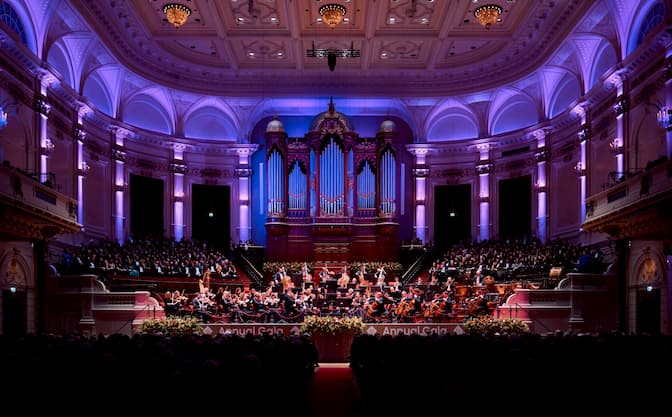Calendar
Filters

Concertgebouw, Amsterdam
Essentials: Schumann’s Symphony No. 3
Klaus Mäkelä conducts Robert Schumann’s vibrant ‘Rhenish’ Symphony
Starting € 20

Concertgebouw, Amsterdam
Klaus Mäkelä conducts Berlioz and Schumann
Berlioz’ Harold en Italie featuring Antoine Tamestit and Schumann’s Symphony No.3 ‘Rhenish’
Starting € 29

Concertgebouw, Amsterdam
Yunchan Lim performs Schumann's Piano Concerto
Jakub Hrůša conducts Dvořák and Suk
Starting € 29

Konzerthaus, Dortmund - Germany
On tour: Yunchan Lim performs Schumann’s Piano Concerto
Jakub Hrůša conducts Dvořák and Suk

Concertgebouw, Amsterdam
Yunchan Lim performs Schumann's Piano Concerto
Jakub Hrůša conducts Dvořák and Suk
Starting € 20

Concertgebouw, Amsterdam
Jaap van Zweden conducts Wagner, Respighi
Leonidas Kavakos performs Korngold’s Violin Concerto
Starting € 29

Concertgebouw, Amsterdam
Jaap van Zweden conducts Wagner, Respighi
Leonidas Kavakos performs Korngold’s Violin Concerto
Starting € 29

Concertgebouw, Amsterdam
Annual Gala featuring Jaap van Zweden
Leonidas Kavakos performs Korngold's cinematic Violin Concerto
Starting € 109

Concertgebouw, Amsterdam
Jaap van Zweden conducts Wagner, Respighi
Leonidas Kavakos performs Korngold’s Violin Concerto
Starting € 29

Concertgebouw, Amsterdam
Nikolaj Szeps-Znaider performs Beethoven's Violin Concerto
Antonio Pappano leads Beethoven and Elgar
Starting € 29

Concertgebouw, Amsterdam
Nikolaj Szeps-Znaider performs Beethoven's Violin Concerto
Antonio Pappano leads Beethoven and Elgar
Starting € 29

Concertgebouw, Amsterdam
Nikolaj Szeps-Znaider performs Beethoven's Violin Concerto
Antonio Pappano leads Beethoven and Elgar
Starting € 29

Kleine Zaal - Het Concertgebouw, Amsterdam
Close-up: The Ballets Russes
Concertgebouw Orchestra musicians perform Stravinsky, Debussy, Prokofiev and Ravel in the Recital Hall
Starting € 38

Concertgebouw, Amsterdam
Klaus Mäkelä conducts Bruckner
Anton Bruckner’s monumental Symphony No. 8
Starting € 29

Concertgebouw, Amsterdam
Klaus Mäkelä conducts Bruckner
Anton Bruckner’s monumental Symphony No. 8
Starting € 29

Concertgebouw, Amsterdam
Klaus Mäkelä conducts Bruckner
Anton Bruckner’s monumental Symphony No. 8
Starting € 29

Philharmonie Luxembourg, Luxembourg
On tour: Klaus Mäkelä conducts Bruckner
Anton Bruckner’s monumental Symphony No. 8

Philharmonie de Paris, Paris - France
On tour: Klaus Mäkelä conducts Bruckner
Anton Bruckner’s monumental Symphony No. 8

Kölner Philharmonie, Cologne - Germany
On tour: Klaus Mäkelä conducts Bruckner
Anton Bruckner’s monumental Symphony No. 8

Elbphilharmonie, Hamburg - Germany
On tour: Klaus Mäkelä conducts Bruckner
Anton Bruckner’s monumental Symphony No. 8